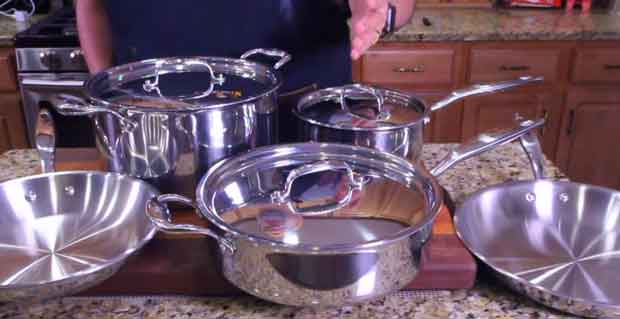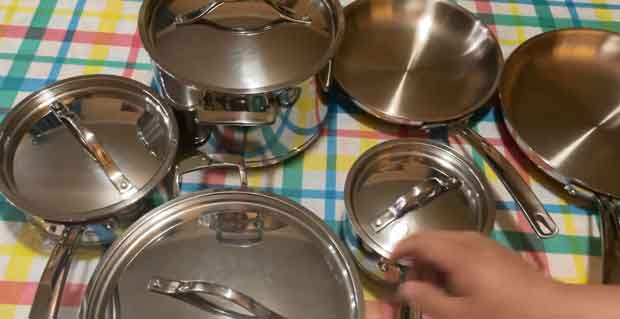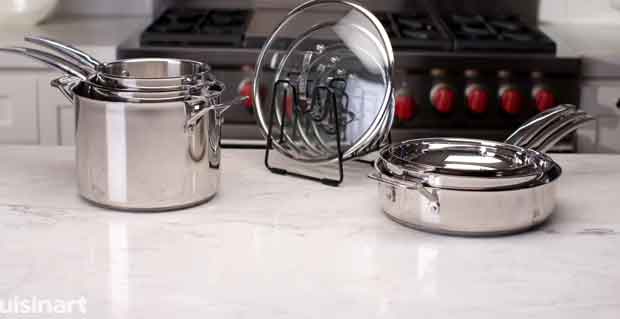The cookware you use can make a big difference in the success of your dish. There are many different types of cookware. One that is often overlooked is the number of layers that it has.
3-ply is thinner and lighter than 5-ply, which means you will need to be more careful with it as not to scratch or dent it. It also heats up quicker and cools down faster than 5-ply, so if you are cooking something for a short period of time this can be an advantage for some people.
Definition of Ply
In the world of cookware, a roasting pan's "ply" is how many layers the pan is constructed. We refer to our cookware as "5 ply" because it is made of five metal layers. A "core" comprises three layers of aluminum, and two outer layers are made of stainless steel cookware (one on top and one on bottom). A similar definition also goes for “3 ply” stainless steel cookware.
Multi-ply Cookware: How it's Made

There are unique properties to every material. The stainless steel coating protects the aluminum from scratches and deformation and reacts with acidic or salty foods. Aluminum has better conductivity, but it is less durable and more challenging to maintain than stainless steel, which means the outer layer should be stainless steel.
A cookware product that combines and layers these metals correctly provides a widely applicable, highly durable, and versatile design-one that heats evenly, responds quickly to changes in temperature, and lasts a lifetime.
Induction stoves are also compatible with the cookware, thanks to the magnetic stainless bottom. Almost all of the heat is distributed by aluminum.
What is 3 ply Cookware?
Generally, a 3-ply pan consists of fused metal layers, usually stainless steel and copper or aluminum.
It is not uncommon for cookware to have a metal bottom or rim. Aluminum is also found on top of many cookware brands, namely Viking cookware, nonstick cookware, etc.
All-Clad’s stainless steel cookware is preferred of 3 ply cookware among cooks and kitchen enthusiasts worldwide. Besides being made in the USA, All-Clad stainless cookware has a three-ply composite design.
Stainless steel is favored for its robustness, as well as its ease of cleaning and maintenance. An aluminum core and stainless steel cladding mean the frying pan will evenly cook your food.
This cookware features a ferromagnetic stainless steel surface that makes it suitable for use with induction cooking, as well as any other heat source available in today's kitchen.
Tri-ply kitchenware is available from many manufacturers. Popular three-ply cookware comprises stainless steel with an aluminum base. Then an anodic coating is put onto the exterior to produce a third coat Third-layer aluminum, which has excellent heat conduction properties and durability. As a result, all the food will be cooked uniformly.
Pros:
3 ply cookware has excellent heat conductivity. It heats quickly and evenly, saving time on meal prep as everything cooks more efficiently.
The steel inside the pan can withstand high temperatures without warping or becoming distorted over time as aluminum does. Plus, unlike other types of vessels (e.g., cast iron), there's no need to season the pan before using it.
Cons:
The downside is that three-ply cookware often costs over 5 ply, and usually weighs less too, which means a greater chance of losing control when cooking over high heat or bumping into something with them in hand (e.g., boiling water).
What is 5 Ply Cookware?

5 ply cookware refers to pots and pans with 5 metal layers. The first layer comprises a nickel or stainless-steel interior (the pan's cooking surface). The following two layers are aluminum, followed by a core of copper that conducts heat exceptionally well. Finally, the exterior finishing layer is made from a nonstick material.
5 ply cookware has excellent heat conductivity like 3 ply does but also distributes heat more evenly. 3 ply is all about playing your cards right by saving up for the best quality cookware and taking care of it to ensure you get what's advertised.
There are two layers on the bottom with a 5 ply pot or pan (one on top and one on bottom). A similar definition also goes for the side walls. The first two layers are aluminum, the third layer is usually stainless steel, and the last one is a nonstick material such as Teflon or ceramic.
Pros:
5 ply cookware heats quicker and more evenly than 3 ply does, which means less cooking time is needed to make sure everything is cooked right. It's also more durable than three-ply and, like we mentioned before, cheaper too so you don't have to break the bank at first but can spend a little more in time for an even better experience with your cookware.
The best part is that the copper core has excellent heat conductivity and disperses it throughout. For this reason, it will save you time on meal prep because everything cooks more efficiently.
here's no need to season your pan before using it either! Plus, you won't have to worry about the metal warping or becoming misshapen over time as aluminum does with five-ply cookware.
Cons:
The downside of five-ply is that it's more expensive than 3 ply and usually weighs less too, which means a greater chance of losing control when cooking over high heat or bumping into something with them in hand (e.g., boiling water).
Differences between 5 Ply and 3 Ply cookware:

Considering all the factors in 3 ply vs 5 ply cookware, the main issue stands out: how many layers of stainless steel are in each pan or pot? 5 plies are 5 layers, while 3 ply is only 3.
- 5 Ply cookware set has 5 stainless steel layers to disperse heat and quickly across your food. These layers mean that 5 layer pot can be used at higher temperatures than a 3 Layer Pot or Pan with metal handles
- 5 Ply frying pan also conducts less of an electric current than the tinier thickness of a 3-layer frying pan does
- A 5 ply fry pan or pot is usually more expensive than a three and heavier when empty, but it always comes with high-quality materials and construction.
- In contrast to the original All-Clad Stainless Steel Tri-Ply d3 cookware, the brushed stainless steel d5 cookware line has 5 metal layers and is more substantial. You'll find it has the same ergonomic handle and flared brims as the Copper Core All-Clad.
Conclusion:
It all boils down to how you plan on using your pans: if you want one for everyday use and don't mind spending money upfront, then go for 3-ply. Otherwise, pay less upfront instead by going for cheaper yet still effective 5 ply.
Also, keep in mind that the thickness of the heat-conductive layer helps spread heat evenly, not the number of layers. The number of plies doesn’t matter in this respect.



